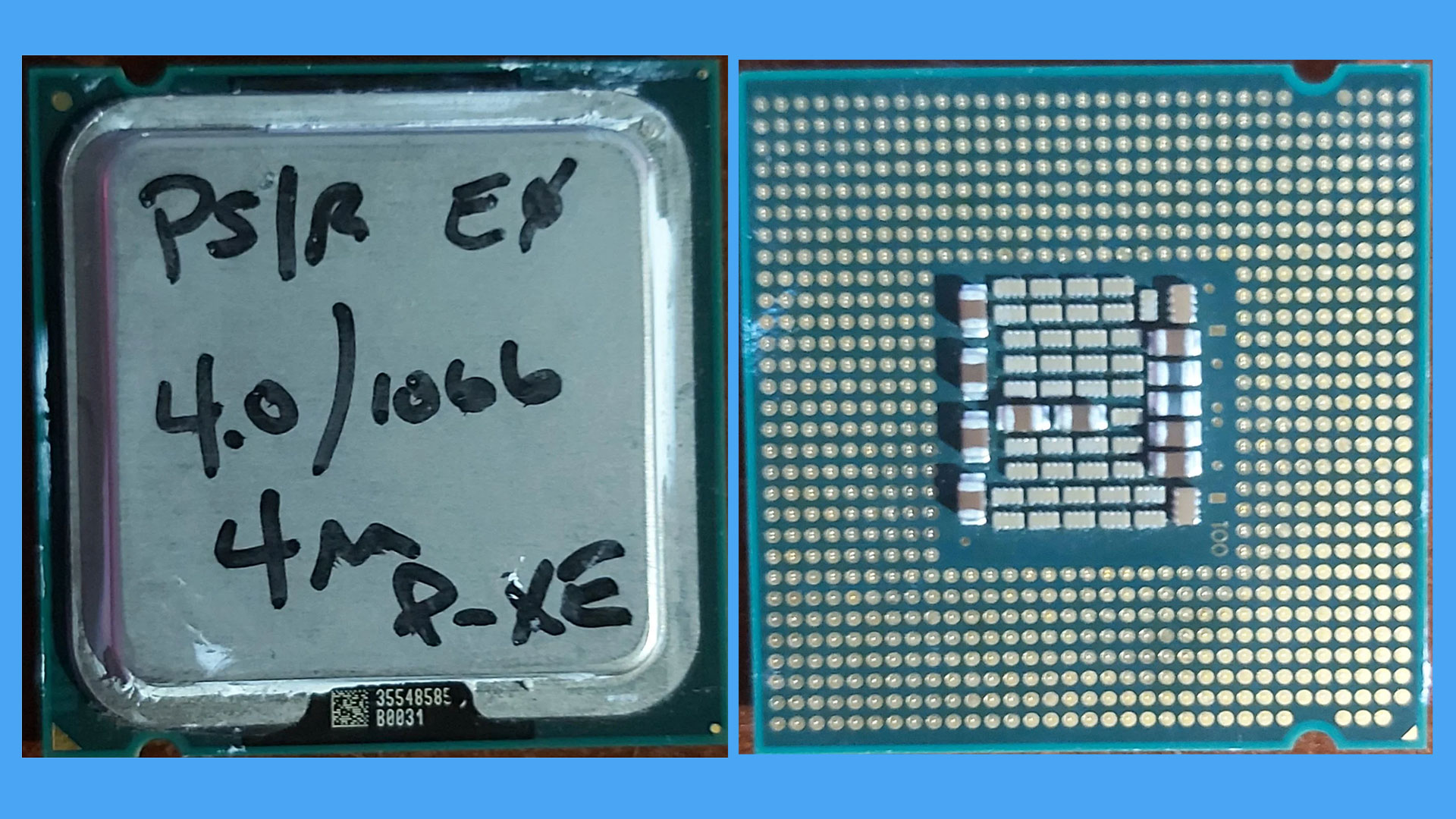Ultra-rare unreleased Pentium 4 with 4.0 GHz clock speed discovered — CPU-Z confirms it is an Intel Pentium Extreme Edition 980
NetBurst’s final gasp wasn’t public, but has now come into clear view.

A rare Intel engineering sample from the twilight of the Pentium 4 era has surfaced on social media. We’ve never seen this 4.0 GHz chip before. On Reddit, the current owner of the purported Intel Pentium Extreme Edition 980 processor, diegunguyman, has shared photos of the chip, both front and back, along with a CPU-Z screenshot for some deeper technical details. Due to quirks with the CPU-Z app/online database, this CPU won’t validate correctly.
Found this Intel Extreme Edition 980 Engineering Sample, Anyone have information on it? from r/intel
Diegunguyman reached out on various Subreddits to try and glean more insight into his find. The basic backstory was that “The only text on the CPU itself was written in Sharpie, just the model number and clock speed, 4 GHz.” With no official documentation to reference, the Redditor turned to experts on Subreddits like r/pcmasterrace and r/Intel to seek answers.
A rare breed
This particular dual-core Hyperthreaded ‘Presler’ P4 is a very interesting sample for a number of reasons. Firstly, the collective wisdom of the flock of attentive Redditors interested in this story indicates that the sample now owned by diegunguyman was likely a loaner chip given to an employee.
These Employee Loaner Chips are rarer than typical Engineering Samples (ES). Their rarity is probably bolstered by the strict terms of the loan. However, a purported Intel ‘insider’ on Reddit indicates that due to the extensive layoffs at the firm, policing of the loaner system has evaporated.
Another interesting aspect of this CPU is the reasons that the public never saw with the pinnacle of NetBurst. It is now a matter for the history books, but the processor line already had a poor reputation for its thermals and performance, which played a part.
Pivot: Plan B becomes Plan A
What likely sealed this ‘ghost’ processor’s fate was Intel’s strategic pivot. Management was already shifting focus to the legendary Core 2 lineup, built on the mobile-first Core microarchitecture. Then we saw Intel’s marketing shift to focusing on the entirely reasonable performance-per-watt metric, and the NetBurst design was quickly relegated to history, with budget / entry-level chips being the primary beneficiaries.
It is probably fair to say Intel’s Haifa design team and its mobile-first Core microarchitecture were Intel’s saviors. From mid-2006, the new performance-per-watt tuned chips managed to effectively stall the momentum of AMD’s contemporaneous CPUs like the Athlon 64 and X2 designs on the desktop.
Get Tom's Hardware's best news and in-depth reviews, straight to your inbox.
Follow Tom's Hardware on Google News, or add us as a preferred source, to get our up-to-date news, analysis, and reviews in your feeds. Make sure to click the Follow button!

Mark Tyson is a news editor at Tom's Hardware. He enjoys covering the full breadth of PC tech; from business and semiconductor design to products approaching the edge of reason.
-
MisterZ I can't understand this sentence... "It is now a matter for the history books, but the thermal and performance limits this processor line already had a poor reputation for, which played a part." - is this a proper sentence?Reply -
bit_user I had high hopes that the 65 nm respin of Netburst/P4 would produce efficiency benefits sufficient to redeem its hyper-pipelined architecture. That didn't seem to play out, unfortunately.Reply -
bit_user Reply
Yeah, I think it was missing a preposition (underlined) and the stricken "for" seems a remnant of a clause that was elided. Perhaps the sentence was also truncated, as it's never specified what "part" it's referring to (presumably Intel's decision not to bring it to market).MisterZ said:I can't understand this sentence... "It is now a matter for the history books, but the thermal and performance limits of this processor line already had a poor reputation for, which played a part." - is this a proper sentence? -
bit_user Reply
Not if Intel was right about it process nodes enabling Pentium 4 to scale up to 10 GHz. At those speeds, the extra pipelining in Netburst's architecture would've definitely paid off.pug_s said:the Mhz race with its netburst architecture is what killed Intel the first time to AMD.
What really killed the P4 was the end of Dennard Scaling.
https://en.wikipedia.org/wiki/Dennard_scaling#Breakdown_of_Dennard_scaling_around_2006
People talk about Pentium 4's failures as though they should've been obvious, but this is only with knowledge we have in highsight that Intel couldn't know when the Pentium 4 was being designed. Some might've predicted Dennard Scaling would end, but nobody knew for sure exactly when. The Pentium 4 designers based the Netburst architecture on what the lithography people told them was achievable. Turns out, they were wrong.
The second major factor in Opteron's success was AMD's embrace of integrated memory controllers. Intel wouldn't make this move until Nehalem (the first gen "Core i"-series). It gave AMD an extra performance edge, over and above having a less clock-dependent microarchitecture.
Finally, AMD was first to deliver x86 CPUs with 64-bit support. Besides a marquee feature, this also provided some further performance benefit, as it doubled the number of registers, thus reducing the number of load/store instructions necessary. -
Thunder64 Replybit_user said:Not if Intel was right about it process nodes enabling Pentium 4 to scale up to 10 GHz. At those speeds, the extra pipelining in Netburst's architecture would've definitely paid off.
What really killed the P4 was the end of Dennard Scaling.
https://en.wikipedia.org/wiki/Dennard_scaling#Breakdown_of_Dennard_scaling_around_2006
People talk about Pentium 4's failures as though they should've been obvious, but this is only with knowledge we have in highsight that Intel couldn't know when the Pentium 4 was being designed. Some might've predicted Dennard Scaling would end, but nobody knew for sure exactly when. The Pentium 4 designers based the Netburst architecture on what the lithography people told them was achievable. Turns out, they were wrong.
The second major factor in Opteron's success was AMD's embrace of integrated memory controllers. Intel wouldn't make this move until Nehalem (the first gen "Core i"-series). It gave AMD an extra performance edge, over and above having a less clock-dependent microarchitecture.
Finally, AMD was first to deliver x86 CPUs with 64-bit support. Besides a marquee feature, this also provided some further performance benefit, as it doubled the number of registers, thus reducing the number of load/store instructions necessary.
I suggest you read the C&C article on the P4. There were many flaws.
https://chipsandcheese.com/p/intels-netburst-failure-is-a-foundation-for-success